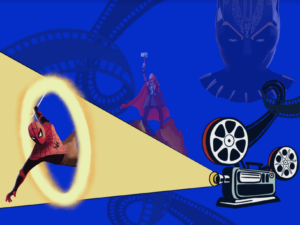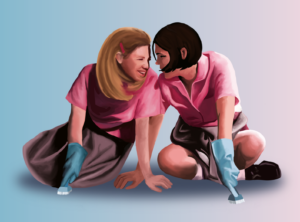The Hunger Games is experiencing a pop culture revival. Fifteen years after the publication of the first book and eleven years after the first movie’s premiere, the young adult (YA) staple is enjoying another moment in the media spotlight. The series, which started trending on TikTok in early March, largely thanks to a steady stream of content from user @luckyleftie, is in the midst of a cultural resurgence that leaves me wondering: why The Hunger Games, and why now?
The dystopian trilogy enjoyed a wave of mass popularity from the publication of the first novel in 2008 to the release of the last film installment in 2015. The Hunger Games is set in a post-apocalyptic world where the majority of resources are controlled by an extremely wealthy few––the residents of the Capitol, whose luxe lifestyles are built on the exploitation of people in the nation’s other provinces, called Districts. The Capitol subordinates the Districts by forcing them to participate in an annual competition where teenage representatives from each District must kill each other to win fame and glory. Our protagonist, Katniss, is one such contestant who (spoiler alert) becomes the unexpected face of a national rebellion against the Capitol.
The Hunger Games hype pretty much died out with the rest of the dystopian YA genre in the late 2010s, after the media landscape became saturated with its flatter, less captivating clones (I’m looking at you, Divergent). So why, in March 2023, did it experience such a sudden revival?
It’s possible that this is all a very clever marketing strategy to build audience excitement ahead of the trilogy’s upcoming spin-off. The film adaptation of The Ballad of Songbirds and Snakes—the prequel novel that tells the origin story of Hunger Games antagonist President Snow—is set to hit theaters this fall. In anticipation of the release, Netflix made all four Hunger Games movies available on its streaming services last month, driving user engagement with the platform.
Netflix’s move coincides with Jennifer Lawrence’s promotion of her new project, No Hard Feelings, which released its official trailer on March 9. In the same month, viewers could see Sam Claflin, who played the fan favorite Finnick Odair in the Hunger Games film series, as fictional frontman Billy Dunne in the Amazon Prime miniseries Daisy Jones & the Six. Ubiquitous pop star Taylor Swift recently released “Safe & Sound (Taylor’s Version)” and “Eyes Open (Taylor’s Version),” re-records of the two singles she performed for The Hunger Games’ original soundtrack. It seems like everyone’s looking to capitalize on the franchise’s resurgence.
And then there’s the fact of our reality. The Hunger Games is rife with glittering images of lavishly costumed rich people while those on the edges of society starve. This spring, coming off of international fashion month and amidst the height of awards season, we’ve been overloaded with images of the ultra wealthy bedecked in outrageous outfits, while the headlines decried food stamp cuts and rising prices for the nation’s neediest. Inflation is still on the rise, and as the Fed hikes rates to try and slow it, consumer anxieties rise with it. The collapse of Silicon Valley Bank in early March revived the memory of the financial crisis of 2008––the same year that The Hunger Games’ first novel was published.
The late aughts/early 2010s context in which The Hunger Games found its initial fame is vital to understanding its critical and popular reception. The first book found immediate success in 2008 and was in production for a film adaptation by 2009. The movie hit theaters in spring of 2012, finding an audience still reeling from the real-life effects of the Great Recession and a cultural awareness of just how wide wealth inequality in America had grown. A decade and a half later, those who were children during the initial wave of the series’ popularity are now young adults, once again facing a period of economic contraction, failing banks, and the Fed’s struggle to contain inflation.
The elements of dystopia that had once been confined to fiction and film no longer seem so far removed. There is something in the apocalyptica of The Hunger Games that resonates in our current moment––something that can’t be explained by a well-executed marketing campaign alone. The Hunger Games, a story about class revolution against an extreme late capitalist society, allows us to individually and collectively realize our anxieties about the future we’re entering––and the present we’re already living in.





